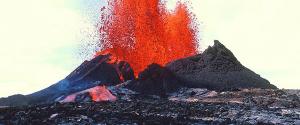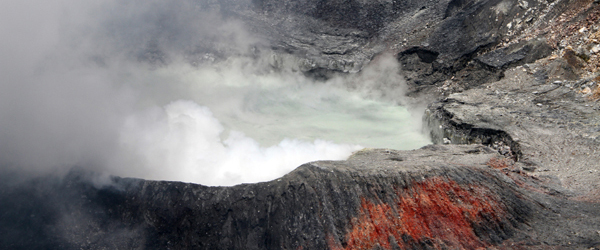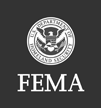Volcanoes

Inspire others to act by being an example yourself, Pledge to Prepare & tell others about it!
A volcano is a mountain that opens downward to a reservoir of molten rock below the surface of the earth. Unlike most mountains, which are pushed up from below, volcanoes are vents through which molten rock escapes to the earth’s surface. When pressure from gases within the molten rock becomes too great, an eruption occurs. Eruptions can be quiet or explosive. There may be lava flows, flattened landscapes, poisonous gases, and flying rock and ash that can sometimes travel hundreds of miles downwind.
Because of their intense heat, lava flows are great fire hazards. Lava flows destroy everything in their path, but most move slowly enough that people can move out of the way.
Fresh volcanic ash, made of pulverized rock, can be abrasive, acidic, gritty, gassy and odorous. While not immediately dangerous to most adults, the acidic gas and ash can cause lung damage to small infants, to older adults and to those suffering from severe respiratory illnesses. Volcanic ash also can damage machinery, including engines and electrical equipment. Ash accumulations mixed with water become heavy and can collapse roofs. Volcanic ash can affect people hundreds of miles away from the cone of a volcano.
Sideways directed volcanic explosions, known as "lateral blasts," can shoot large pieces of rock at very high speeds for several miles. These explosions can kill by impact, burial or heat. They have been known to knock down entire forests.
Volcanic eruptions can be accompanied by other natural hazards, including earthquakes, mudflows and flash floods, rock falls and landslides, acid rain, fire, and (under special conditions) tsunamis.
Active volcanoes in the U.S. are found mainly in Hawaii, Alaska and the Pacific Northwest. The danger area around a volcano covers approximately a 20-mile radius however some danger may exist 100 miles or more from a volcano.
 Before a Volcanic Eruption
Before a Volcanic Eruption
The following are things you can do to protect yourself, your family and your property in the event of a volcanic eruption.
- Build an Emergency Supply Kit, which includes items like non-perishable food, water, a battery-powered or hand-crank radio, extra flashlights and batteries. You may want to prepare a portable kit and keep it in your car in case you are told to evacuate. This kit should also include a pair of goggles and disposable breathing masks for each member of the family.
- Make a Family Emergency Plan. Your family may not be together when disaster strikes, so it is important to know how you will contact one another, how you will get back together and what you will do in case of an emergency.
During a Volcanic Eruption
- Follow the evacuation order issued by authorities and evacuate immediately from the volcano area to avoid flying debris, hot gases, lateral blast and lava flow.
- Be aware of mudflows. The danger from a mudflow increases near stream channels and with prolonged heavy rains. Mudflows can move faster than you can walk or run. Look upstream before crossing a bridge and do not cross the bridge if a mudflow is approaching.
- Avoid river valleys and low-lying areas.
- Remember to help your neighbors who may require special assistance - infants, elderly people and people with access and functional needs.
Protection From Falling Ash
- If you are unable to evacuate, and in order to protect yourself from falling ash, you should remain indoors with doors, windows and ventilation closed until the ash settles.
- If you have a respiratory ailment, avoid contact with any amount of ash. Stay indoors until local health officials advise it is safe to go outside.
- Listen to a battery-powered radio or television for the latest emergency information.
- Wear long-sleeved shirts and long pants.
- Use goggles and wear eyeglasses instead of contact lenses.
- Use a dust mask or hold a damp cloth over your face to help with breathing.
- Stay away from areas downwind from the volcano to avoid volcanic ash.
- Stay indoors until the ash has settled unless there is a danger of the roof collapsing.
- Close doors, windows, and all ventilation in the house (chimney vents, furnaces, air conditioners, fans and other vents.
- Clear heavy ash from flat or low-pitched roofs and rain gutters.
- Avoid running car or truck engines. Driving can stir up volcanic ash that can clog engines, damage moving parts, and stall vehicles.
- Avoid driving in heavy ash fall unless absolutely required. If you have to drive, keep speed down to 35 MPH or slower.
After a Volcanic Eruption
- Go to a designated public shelter if you have been told to evacuate or you feel it is unsafe to remain in your home. Text SHELTER + your ZIP code to 43362 (4FEMA) to find the nearest shelter in your area (example: shelter 12345).
- Local authorities may not immediately be able to provide information on what is happening and what you should do. However, you should listen to NOAA Weather Radio, watch TV, listen to the radio or check the Internet often for official news and instructions as they become available.
Publications
U.S. Geological Survey
- Volcano Hazards Program. Website with volcano activity updates, feature stories, information about volcano hazards and resources. Available online at: http://volcanoes.usgs.gov
Related Websites
Find additional information on how to plan and prepare for a volcanic eruption and learn about available resources by visiting the following websites:
- Federal Emergency Management Agency
- NOAA Watch
- American Red Cross
- U.S. Geological Survey Volcano Hazards Program
Listen to Local Officials
Learn about the emergency plans that have been established in your area by your state and local government. In any emergency, always listen to the instructions given by local emergency management officials.



